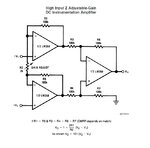cmotif
Newbie level 4

I am trying to hook up a pressure sensor
 to a National Instruments DAQ analog input to read the pressure reading.
to a National Instruments DAQ analog input to read the pressure reading.
However as the sensor is unamplified it is too noisy to read. I built an instrumentation amplifier to amplify the circuit with some LM358N that I had lying around. I followed the example circuit in the data sheet.

Using an excitation voltage of 12V for the pressure sensor, and the same 12V for the LM358N single supply.
It seems to be working, with a caveat, I do not get the calculated amplification. I am using R1 =100K and R2 = 10K, which should give me a gain of 21.
However using a 500mV square wave, i could only obtain a 1V square wave on the output.
I am not sure what is going on here though I my guess is that the opamp output does not have enough voltage to swing about.
Could some one help me out here?
Thanks!
 to a National Instruments DAQ analog input to read the pressure reading.
to a National Instruments DAQ analog input to read the pressure reading.However as the sensor is unamplified it is too noisy to read. I built an instrumentation amplifier to amplify the circuit with some LM358N that I had lying around. I followed the example circuit in the data sheet.

Using an excitation voltage of 12V for the pressure sensor, and the same 12V for the LM358N single supply.
It seems to be working, with a caveat, I do not get the calculated amplification. I am using R1 =100K and R2 = 10K, which should give me a gain of 21.
However using a 500mV square wave, i could only obtain a 1V square wave on the output.
I am not sure what is going on here though I my guess is that the opamp output does not have enough voltage to swing about.
Could some one help me out here?
Thanks!
Last edited:


